Rapid Evaluation and Analysis of the Deformation of Filled Cylindrical Casing with Deforming Charge Width Based on Self-Compiled MATLAB Program
Abstract
:1. Introduction
2. Criterion α for Measuring the Deformable Surface Width
2.1. Establishment of Criterion α
2.2. Optimum Range of Criterion α
3. Self-Compiled MATLAB Rapid Evaluation Program
3.1. Parameter Initialization of the MATLAB Rapid Evaluation Program
3.2. Verification of the Rapid Evaluation Program Based on LS-DYNA
3.3. Verification of the Rapid Evaluation Program Based on the Experiments
4. Analysis and Discussion of the Results
4.1. Effect of Deforming Charge Width on Filled Cylindrical Casing
- (1)
- If the deforming charge width is too small, the resulting load will be distributed in a relatively narrow region. At this moment, fewer and relatively concentrated casing elements are driven by the lateral explosion, so that the difference in relative azimuth between the casing elements and the circle center is smaller. When velocity decomposition is performed, the velocity in the horizontal direction is larger, and the velocity of the casing elements at the loading region center is slightly larger than those at both ends. As a result, the deformed surface of the casing eventually results in an approximate “inner-concave” type.
- (2)
- If the deforming charge width is too large, the resulting load will be distributed in a relatively wider region, and more casing elements are driven by the lateral explosion. The wide loading region creates a large difference in the relative azimuths of the casing elements and the circle center. The difference in the azimuth angles will cause a greater difference in the velocity decomposition in the horizontal and vertical direction. The closer the casing element to the outside, the greater the velocity of its decomposition in the vertical direction, and the lower in the horizontal direction. Therefore, the final deformation surface is similar to the “outer-convex” type.
- (3)
- As the deforming charge width increases, the deformation surface of the casing gradually transfers from the inner-concave to outer-convex shape. Therefore, we inferred that a suitable width of the deforming charge must exist to make the corresponding deformation surface of the casing D-shaped.
4.2. Relationship between Deforming Dharge Width φ and Criterion α
5. Conclusions
Author Contributions
Funding
Acknowledgments
Conflicts of Interest
References
- Kempton, M.L. Selectively Aimable Warhead. U.S. Patent 4,026,213, 31 May 1977. [Google Scholar]
- Konig, P.J.; Mostert, F.J. The Results of a Deformable Warhead Technology Exercise. In Proceedings of the 20th International Symposium on Ballistics (ISB’20), Orlando, FL, USA, 23–27 September 2002. [Google Scholar]
- Lloyd, R.M. Conventional Warhead Systems Physics and Engineering Design; American Institute of Aeronautics and Astronautics: Washington, DC, USA, 1998. [Google Scholar]
- Fairlie, G.E.; Marriott, C.O.; Robertson, N.J.; Livingstone, I.; Birnbaum, N. Computer Modelling of Full Size Fragmenting Aimable Warheads Using AUTODYN-3D. In Proceedings of the 17th International Symposium on Ballistics (ISB’17), Midrand, South Africa, 23–27 March 1998. [Google Scholar]
- Tennyson, R.C. The Effect of Shape Imperfection and Stiffening on the Buckling of Circular Cylinders. In Buckling of Structures; Springer: Berlin, Germany, 1976; pp. 251–273. [Google Scholar]
- Lindberg, H.E.; Florence, A.L. Dynamic Pulse Buckling; Martinus Nijhoff Publishers: Leiden, The Netherlands, 1987. [Google Scholar]
- Gefken, P.R.; Kirkpatric, S.W.; Hoimes, B.S. Response of Impulsively Loaded Cylindrical Shells. Int. J. Impact Eng. 1988, 7, 213–227. [Google Scholar] [CrossRef]
- Kirkpatric, S.W.; Hoimes, B.S. Structural Response of Thin Cylindrical Shells Subjected to Impulsive External Loads. AIAA J. 1988, 26, 96–103. [Google Scholar] [CrossRef]
- Yakupov, R.G. Plastic Deformations of a Cylindrical Shell under the Action of a Planar Explosion Wave. J. Appl. Mech. Tech. Phys. 1982, 14, 579–584. [Google Scholar] [CrossRef]
- Yakupov, R.G. Plastic Strains in a Cylindrical Shell under the Effect of a Spherical Blast Wave. Strength Mater. 1982, 14, 52–56. [Google Scholar] [CrossRef]
- Wierzbicki, T.; Hoo Fatt, M.S. Damage Assessment of Cylinders due to Impact and Explosive Loading. Int. J. Impact Eng. 1993, 13, 215–244. [Google Scholar] [CrossRef]
- Hoo Fatt, M.S.; Wierzbicki, T. Damage of Plastic Cylinders under Localized Pressure Loading. Int. J. Mech. Sci. 1991, 33, 999–1016. [Google Scholar] [CrossRef]
- Hu, G.Y.; Xia, G.; Li, J. The Transient Responses of Two-Layered Cylindrical Shells Attacked by Underwater Explosive Shock Waves. Compos. Struct. 2010, 92, 1551–1560. [Google Scholar]
- Yao, X.L.; Guo, J.; Feng, L.H.; Zhang, A.M. Comparability Research on Impulsive Response of Double Stiffened Cylindrical Shells Subjected to Underwater Explosion. Int. J. Impact Eng. 2009, 36, 754–762. [Google Scholar] [CrossRef]
- Li, J.; Rong, J.L. Experimental and Numerical Investigation of the Dynamic Response of Structures Subjected to Underwater Explosion. Eur. J. Mech. B/Fluids 2012, 32, 59–69. [Google Scholar] [CrossRef]
- Hung, C.F.; Lin, B.J.; Hwang-Fuu, J.J.; Hsu, P.Y. Dynamic Response of Cylindrical Shell Structures Subjected to Underwater Explosion. Ocean Eng. 2009, 36, 564–577. [Google Scholar] [CrossRef]
- Ma, X.Q.; Stronge, W.J. Spherical Missile Impact and Perforation of Filled Tubes. Int. J. Impact Eng. 1988, 3, 1–16. [Google Scholar]
- Neilson, A.J.; Howe, W.D.; Garton, G.P. Impact Resistance of Mild Steel Pipes: An Experimental Study; UKAEA Atomic Energy Establishment AEEW-R-2125: Abingdon, UK, 1987. [Google Scholar]
- Li, Z.; Zhang, S.Y.; Yang, G.T. The Global Deformation and Local Damage Analysis of Filled Metallic Cylindrical Shells Impact by Missiles. Acta Mech. Solida Sin. 1999, 20, 303–309. [Google Scholar]
- Jama, H.H.; Nurick, G.N.; Bambach, M.R.; Grzebieta, R.H.; Zhao, X.L. Steel Square Hollow Sections Subjected to Transverse Blast Loads. Thin-Walled Struct. 2012, 53, 109–122. [Google Scholar] [CrossRef]
- Li, L.J.; Jiang, W.K.; Ai, Y.H. Experimental Study on Deformation and Shock Damage of Cylindrical Shell Structures Subjected to Underwater Explosion. Proc. Inst. Mech. Eng. Part C J. Mech. Eng. Sci. 2010, 224, 2505–2514. [Google Scholar] [CrossRef]
- Ding, L.L.; Li, X.Y.; Lu, F.Y.; Zhang, S.X.; Li, X.Y. Research on Deformation Mechanism of Cylindrical Shell Filled with Medium under Lateral Explosion Loading. Acta Armamentarii 2017, 38, 24–29. [Google Scholar]
- Ding, L.L.; Li, Z.D.; Liang, M.Z.; Li, X.Y.; Lu, F.Y. The Dispersion Rule of Fragments about the Asymmetric Shell. Shock Vib. 2017, 2017, 9810978. [Google Scholar] [CrossRef]
- Ding, L.L.; Li, Z.D.; Lu, F.Y.; Li, X.Y. Research into the Energy Output of Asymmetric Cylindrical Structure under Internal Explosion Loading. Energies 2018, 11, 967. [Google Scholar] [CrossRef]
- Ding, L.L.; Li, Z.D.; Lu, F.Y.; Li, X.Y. Rapid Assessment of the Spatial Distribution of Fragments about the D-Shaped Structure. Adv. Mech. Eng. 2018, 10, 1–16. [Google Scholar] [CrossRef]
- Li, X.Y.; Li, Z.D.; Liang, M.Z. An Analytical Approach for Deformation Shapes of a Cylindrical Shell with Internal Medium Subjected to Lateral Contact Explosive Loading. Math. Probl. Eng. 2015, 2015, 563097. [Google Scholar] [CrossRef]
- Beijing Institute of Technology «explosion and its effects» Compile Group. Explosion and Its Effects; National Defense Industry Press: Beijing, China, 1979; pp. 257–263. [Google Scholar]
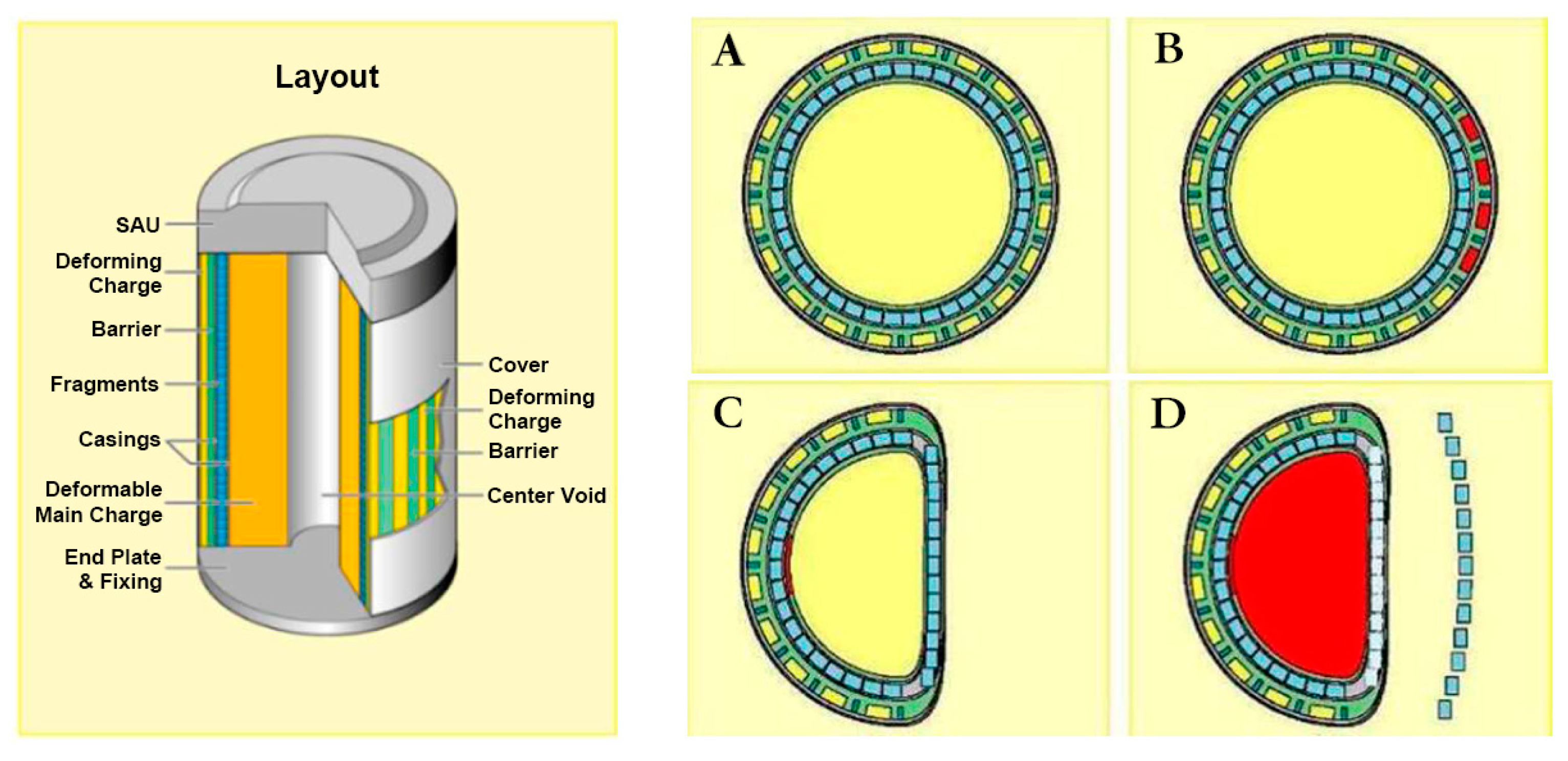
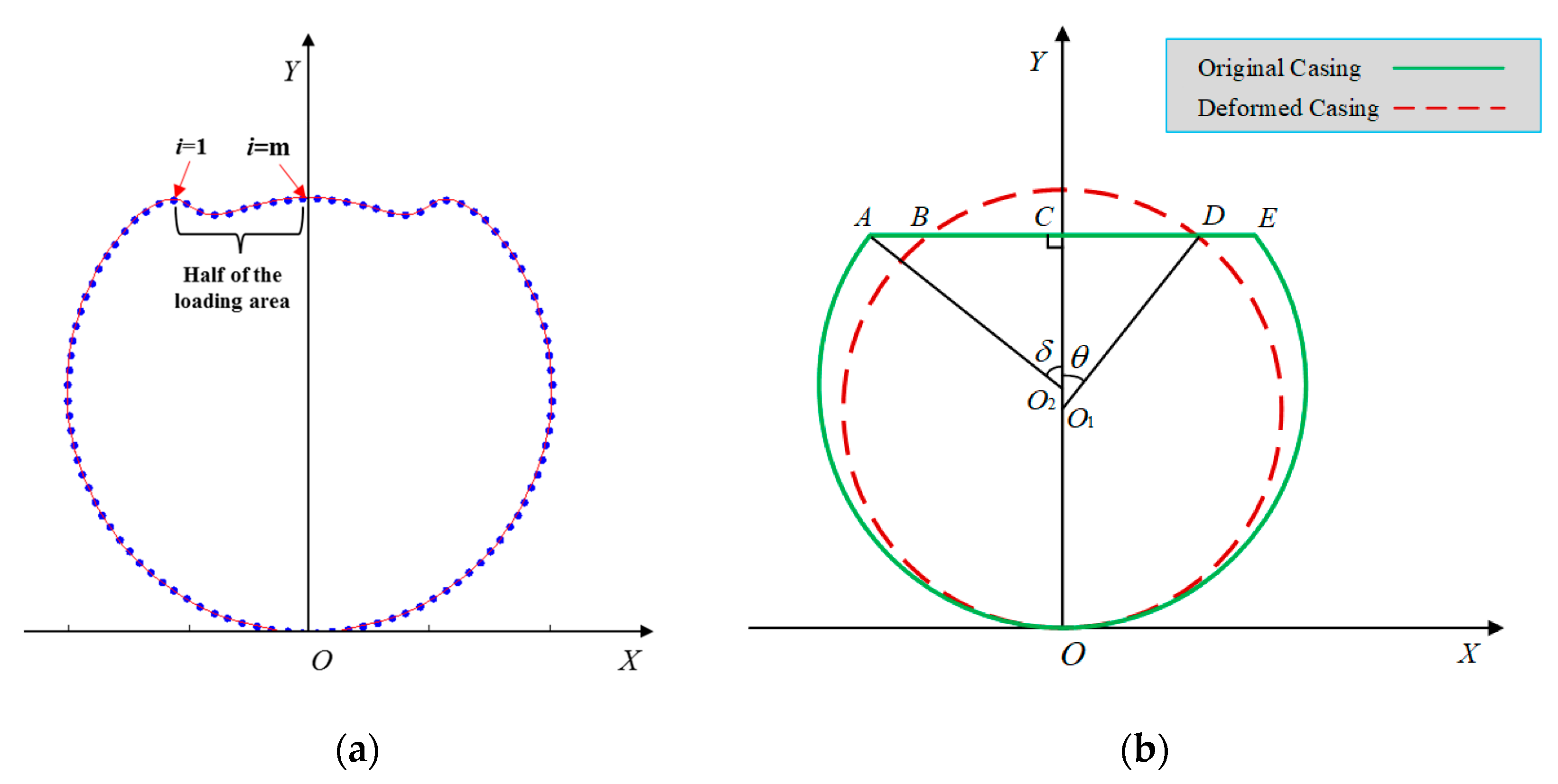

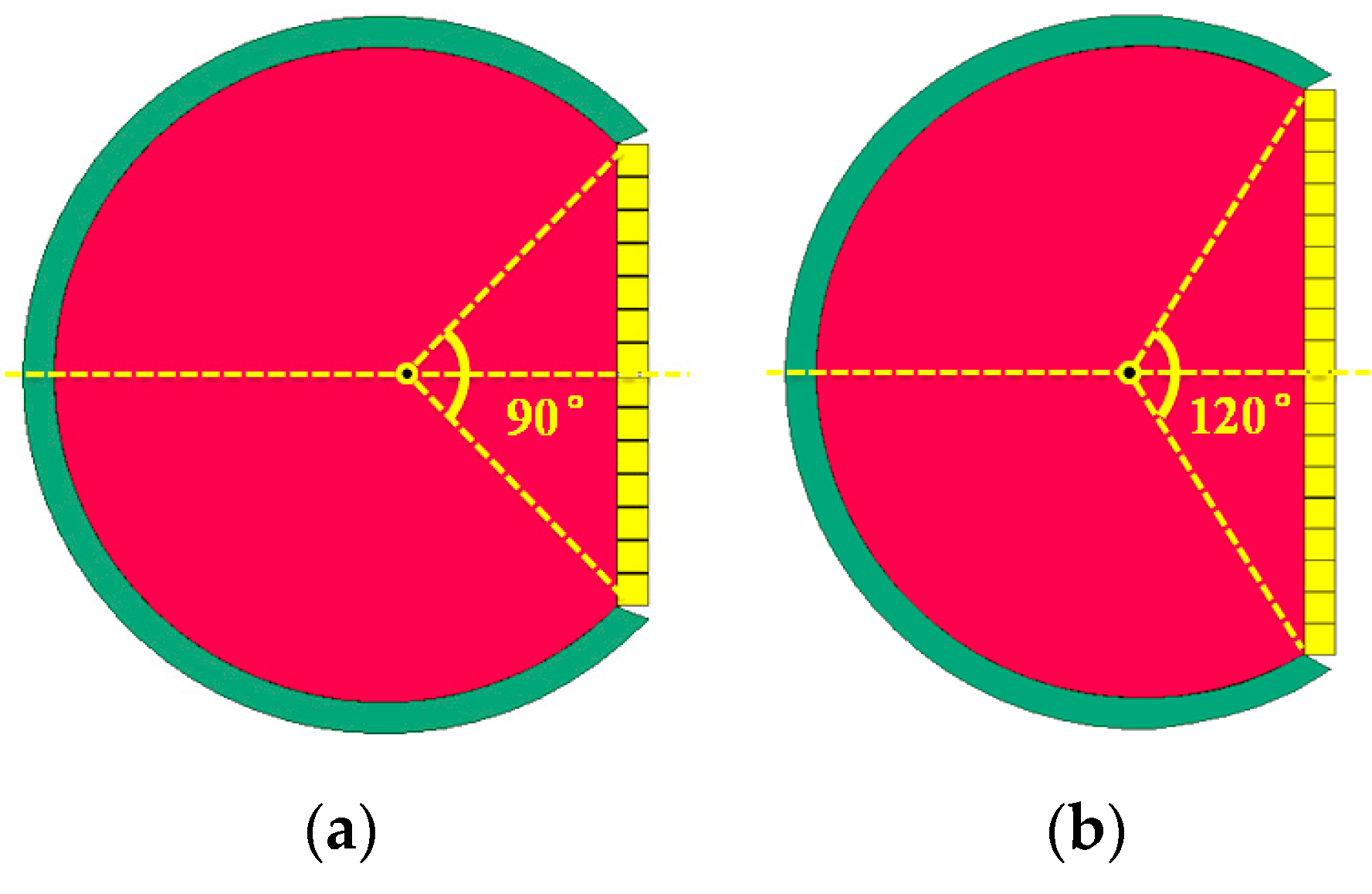
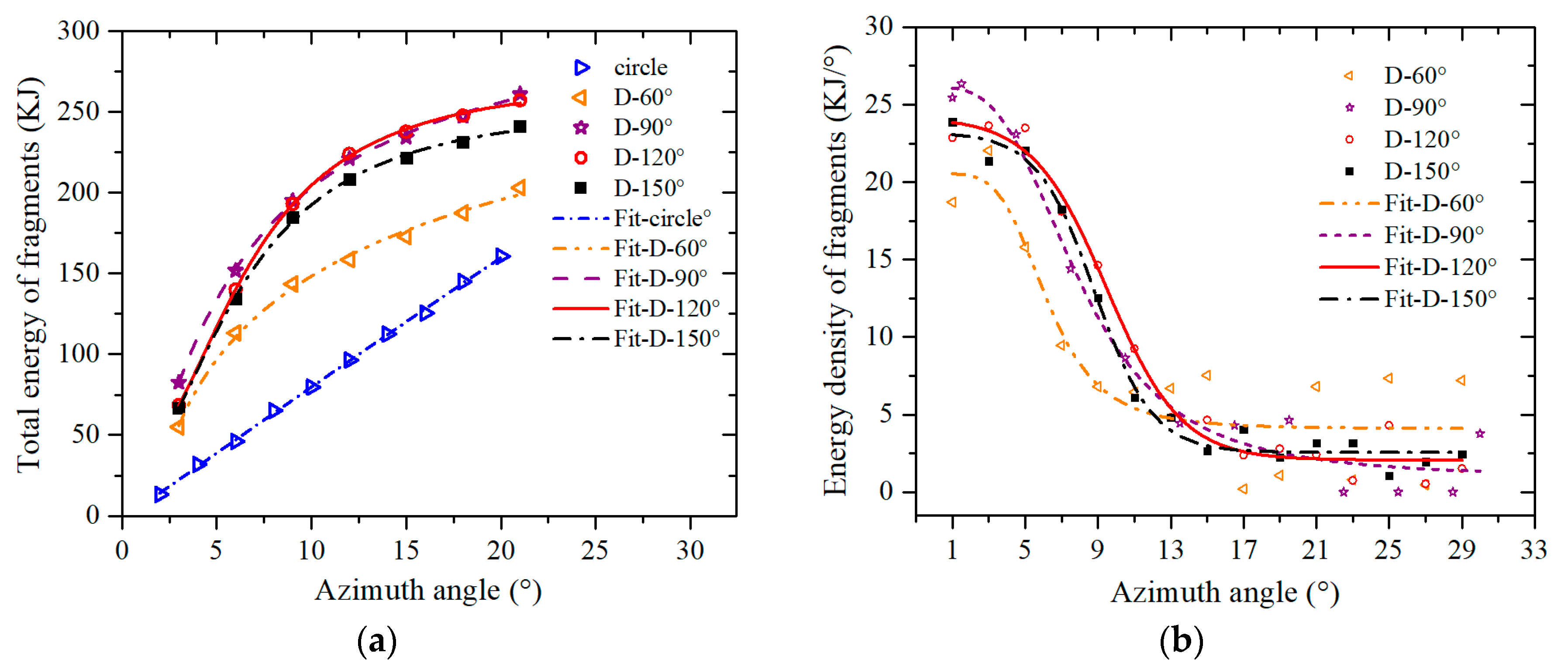
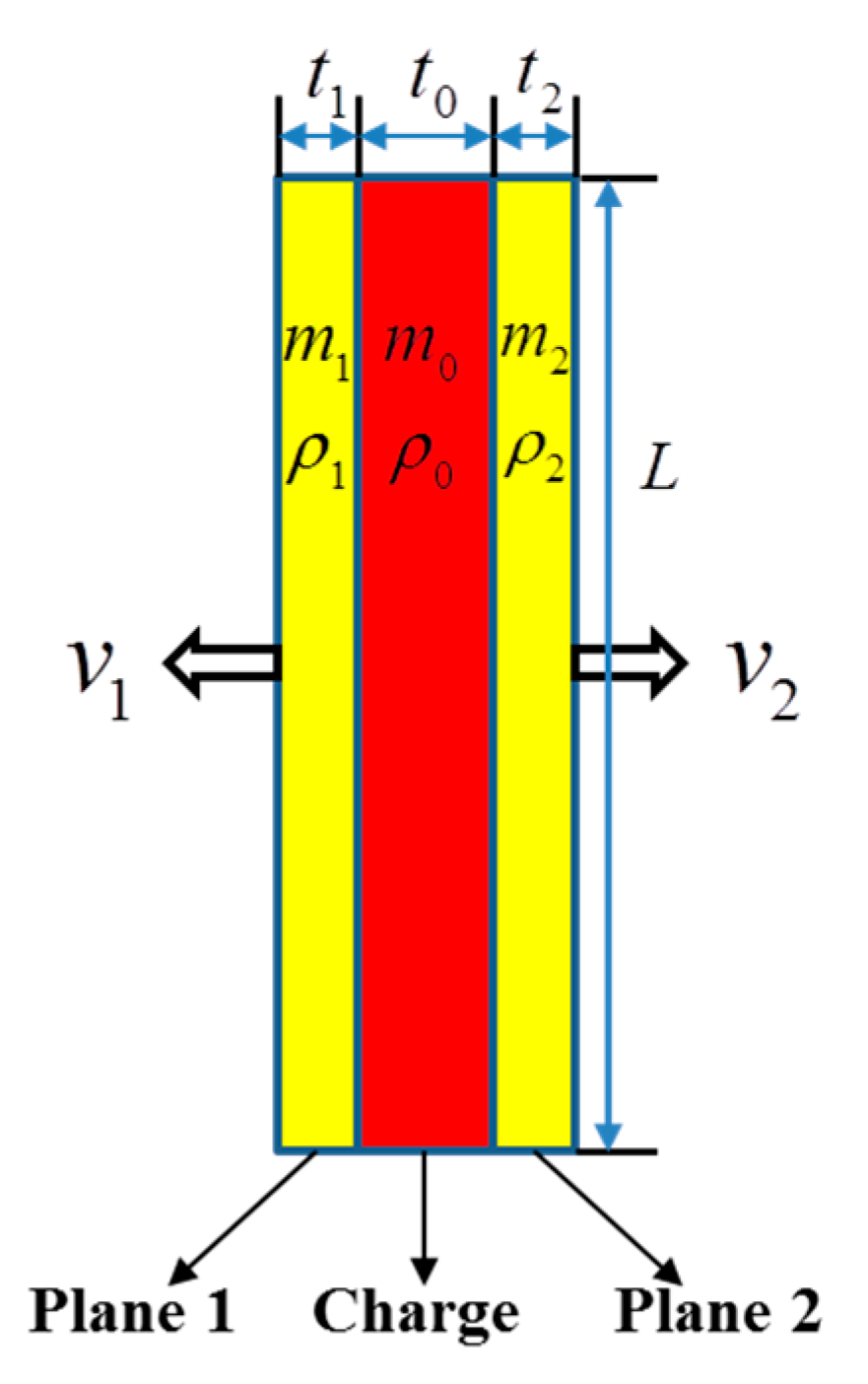
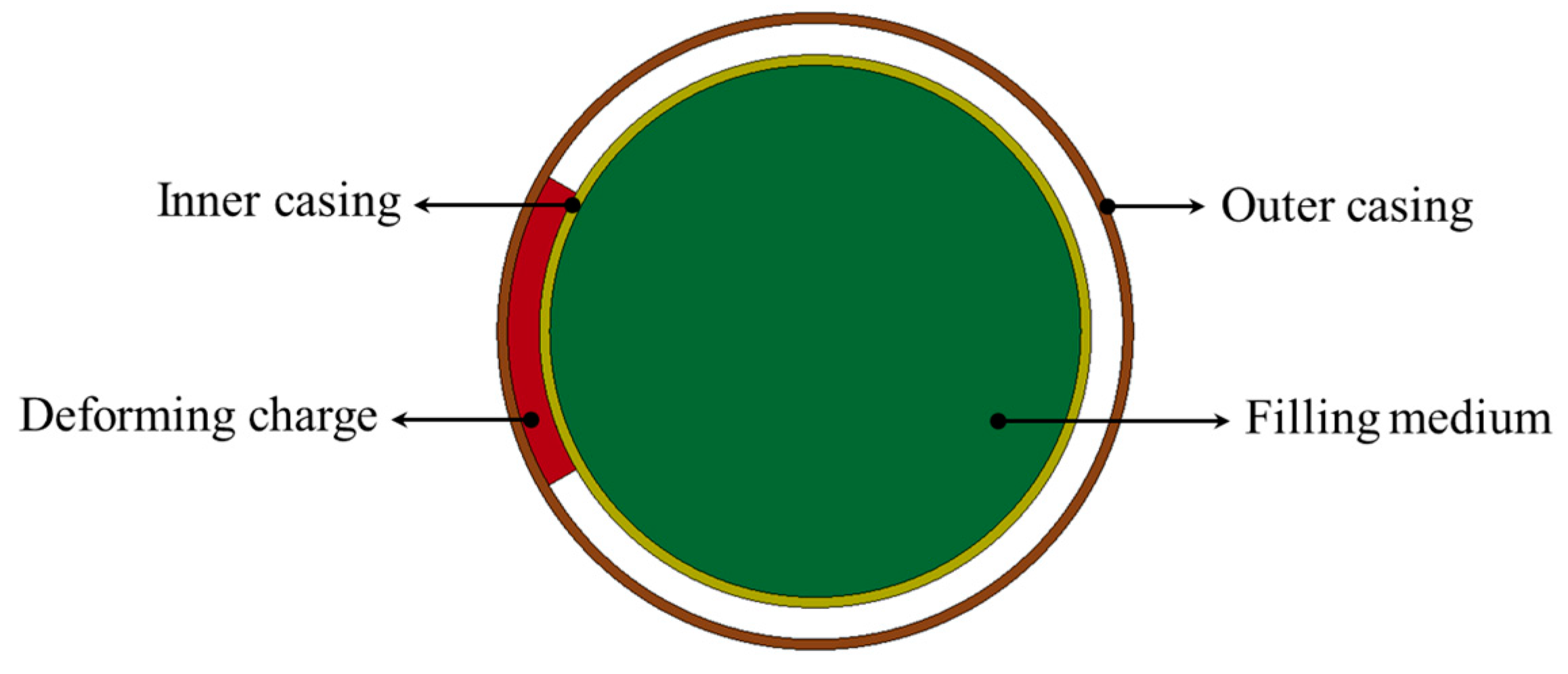
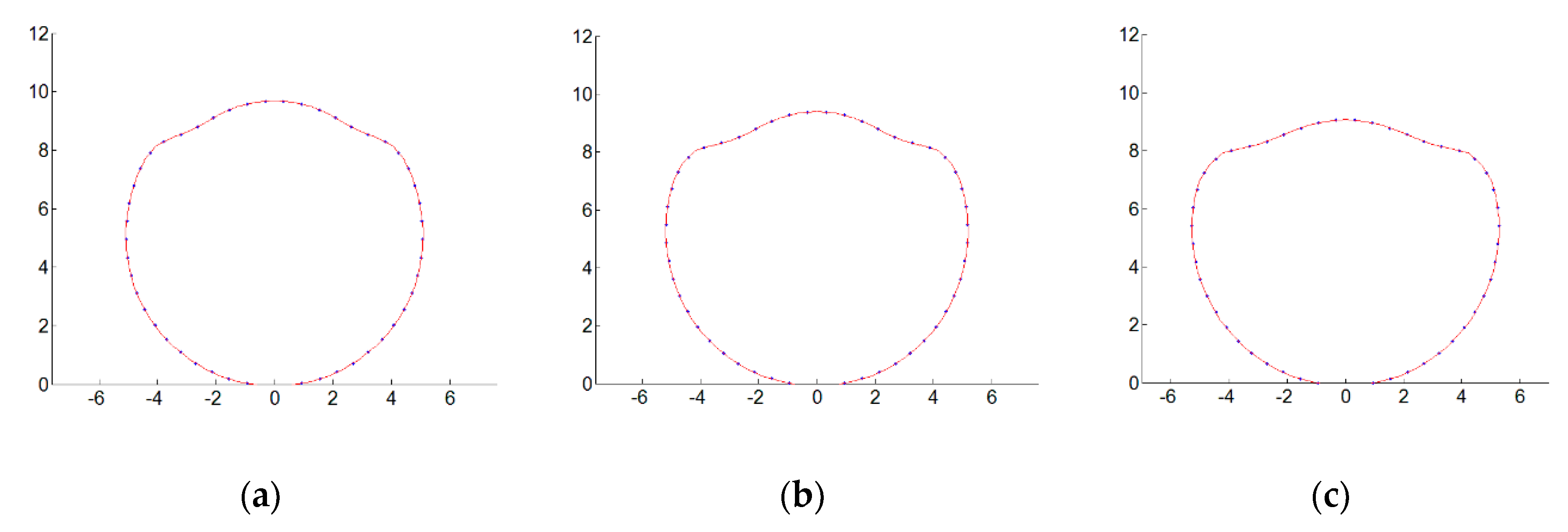


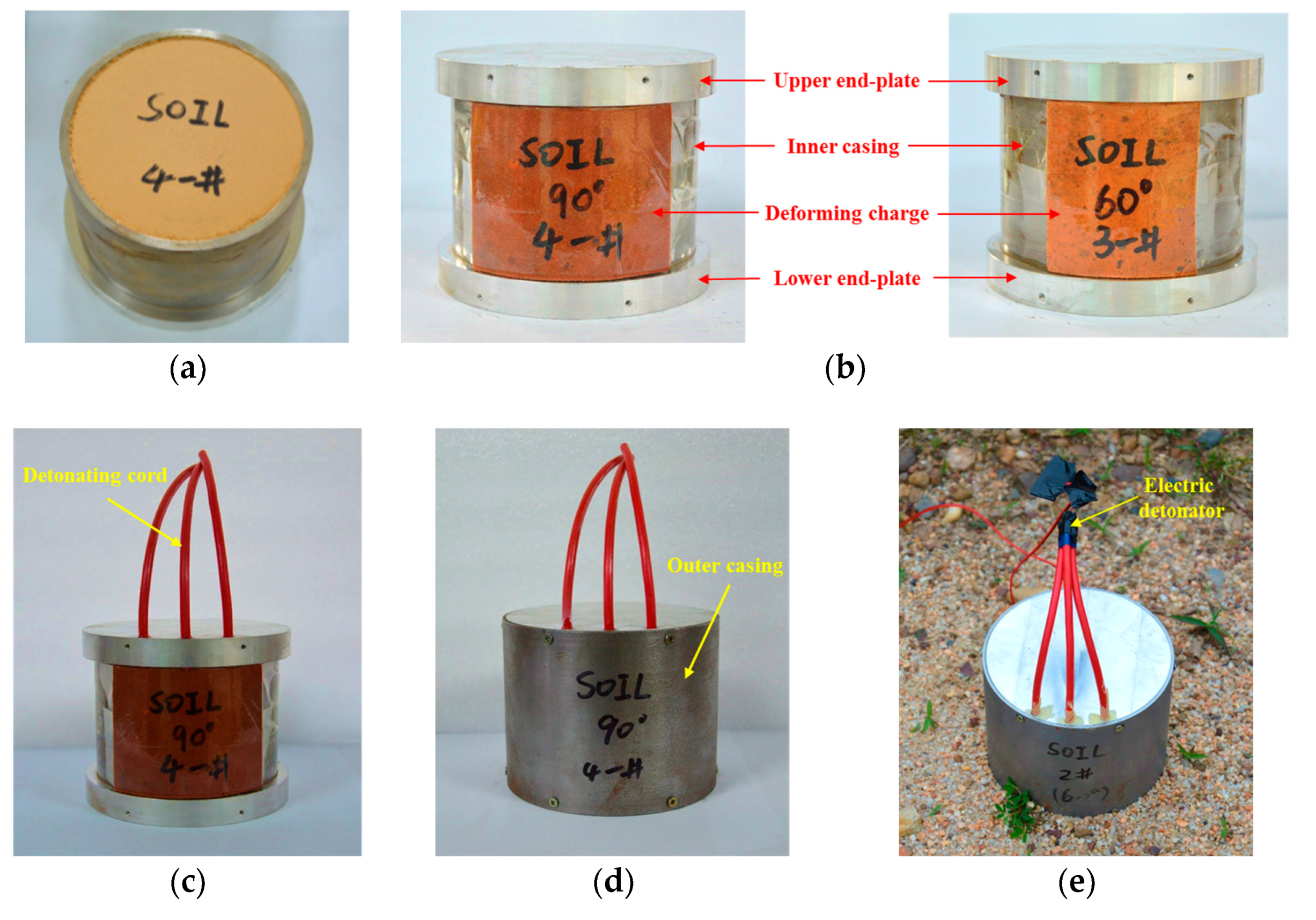
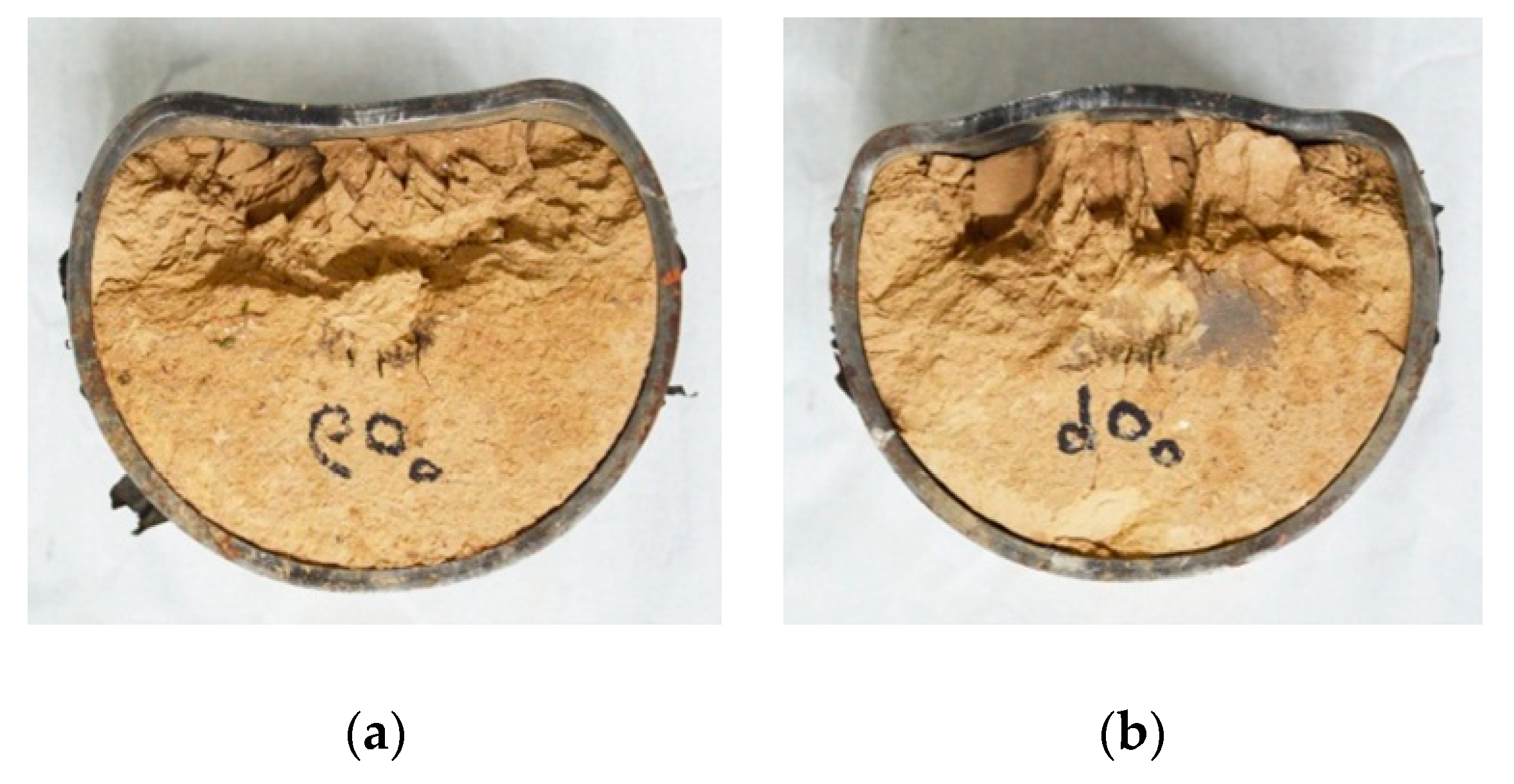
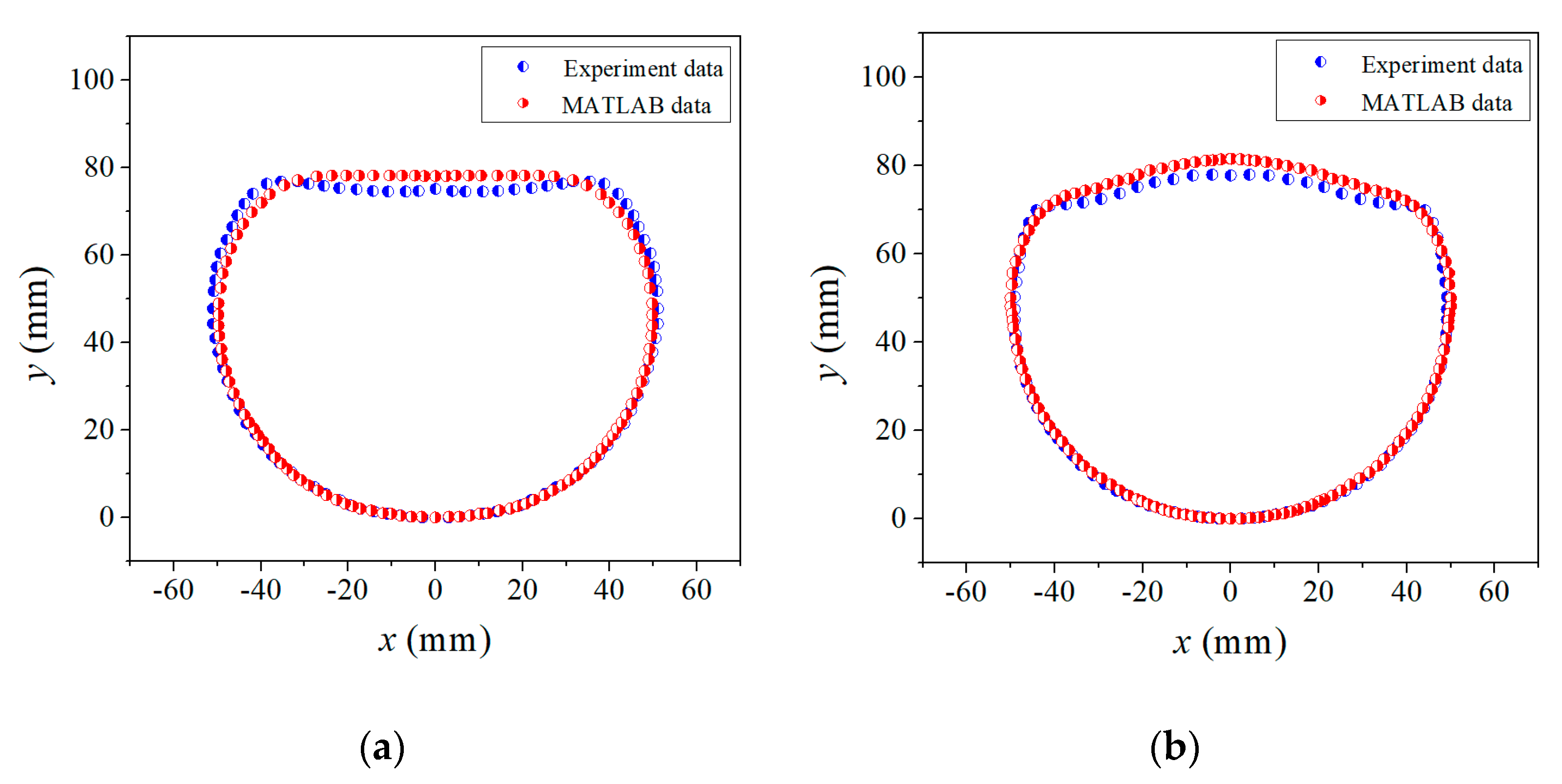

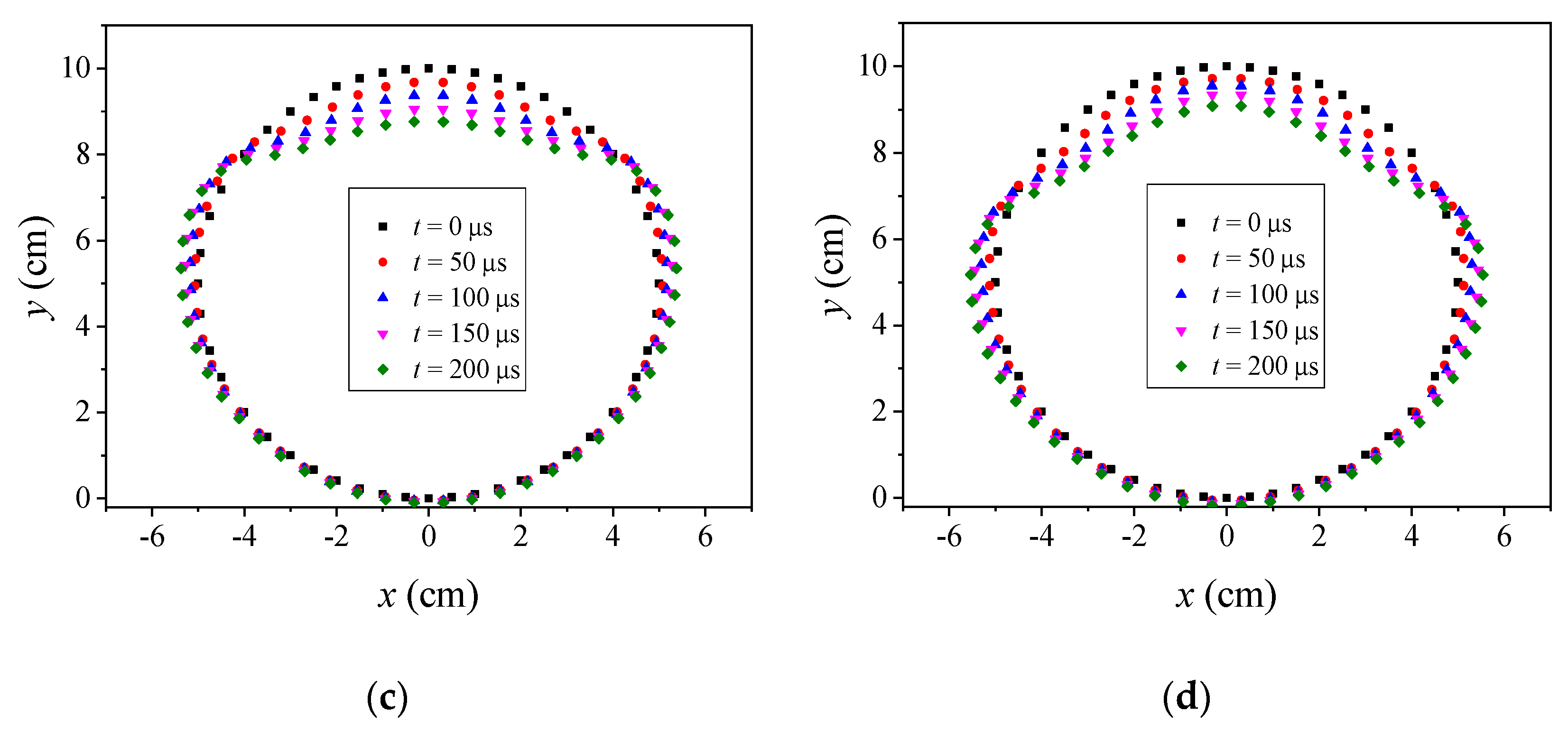
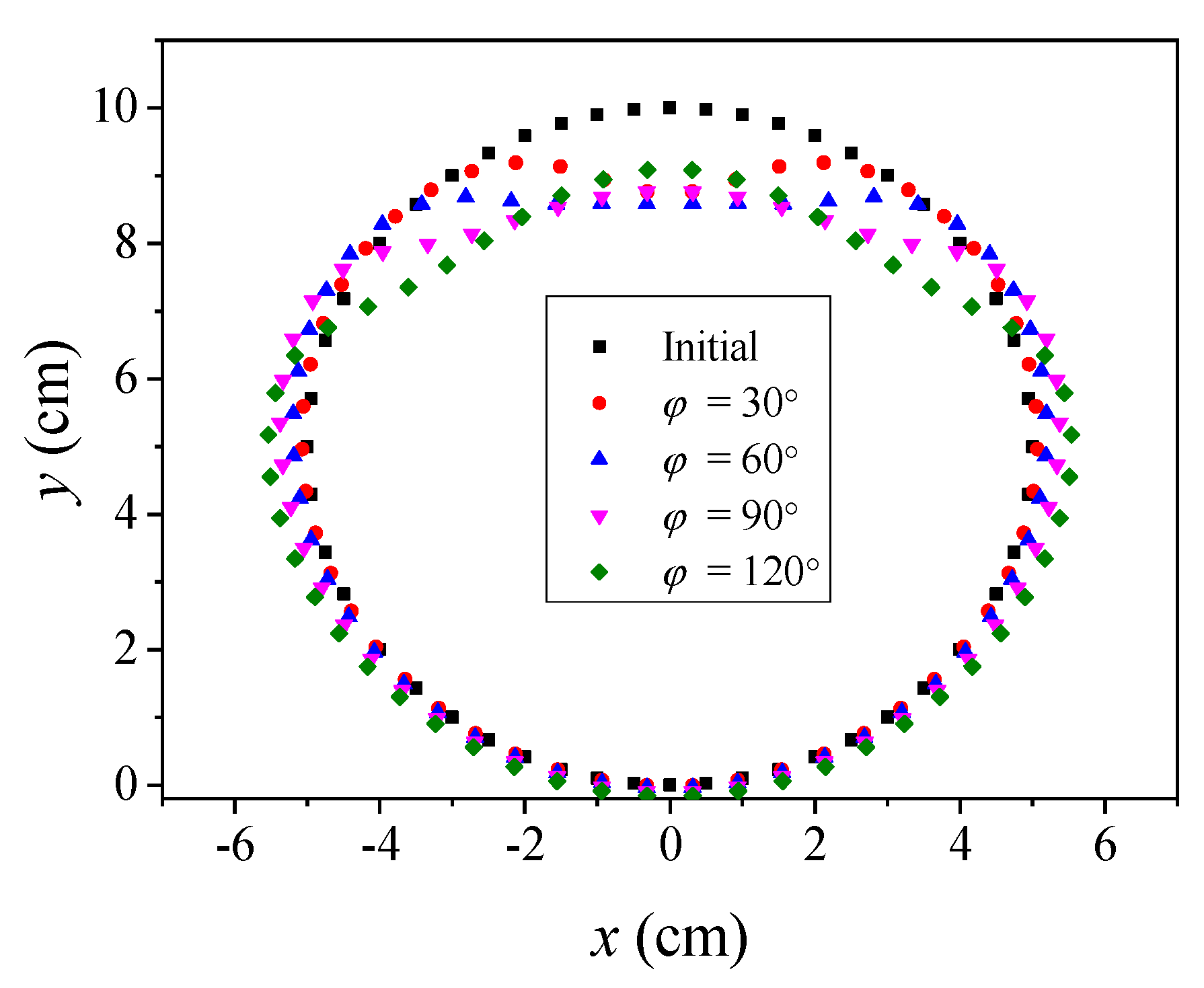
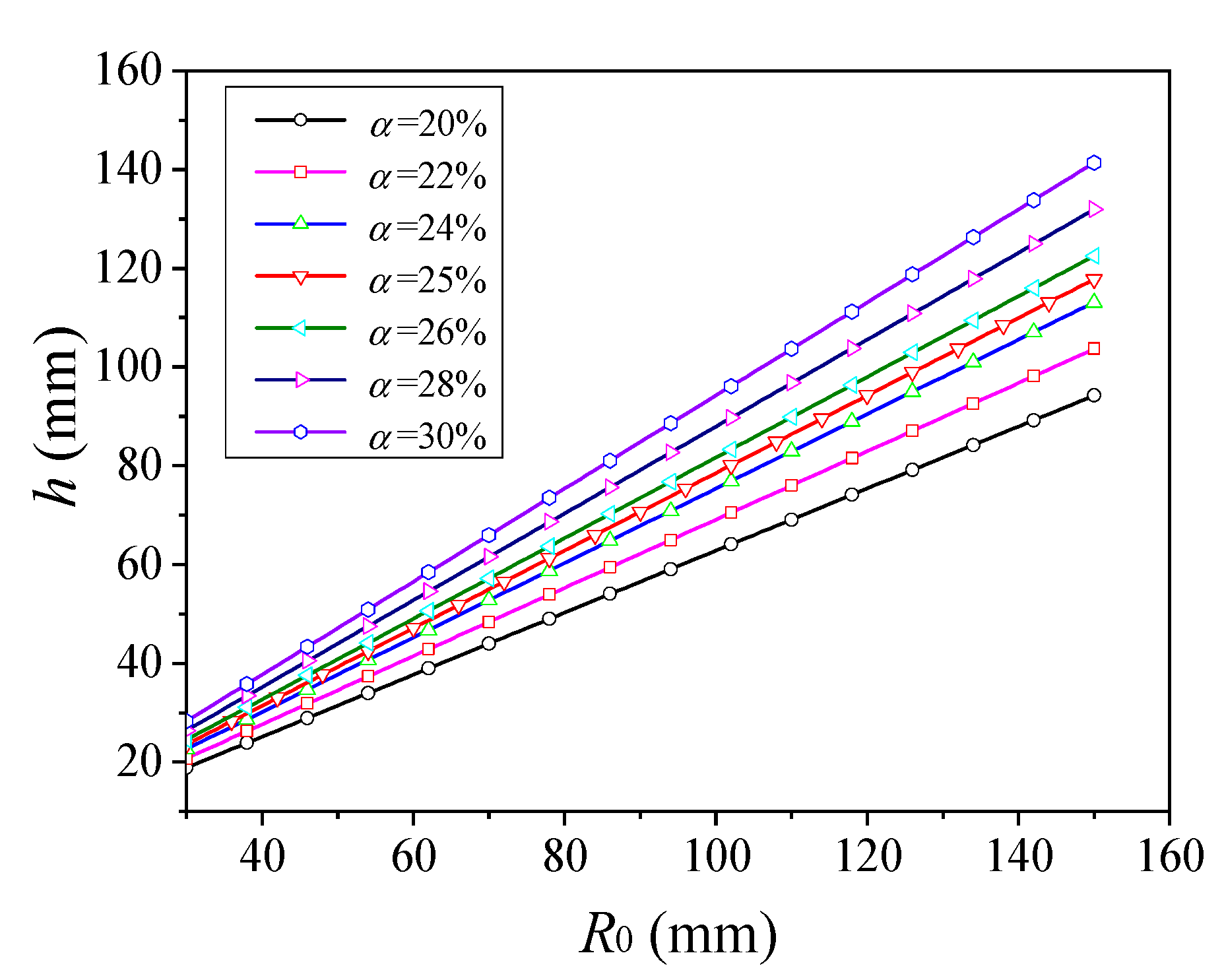

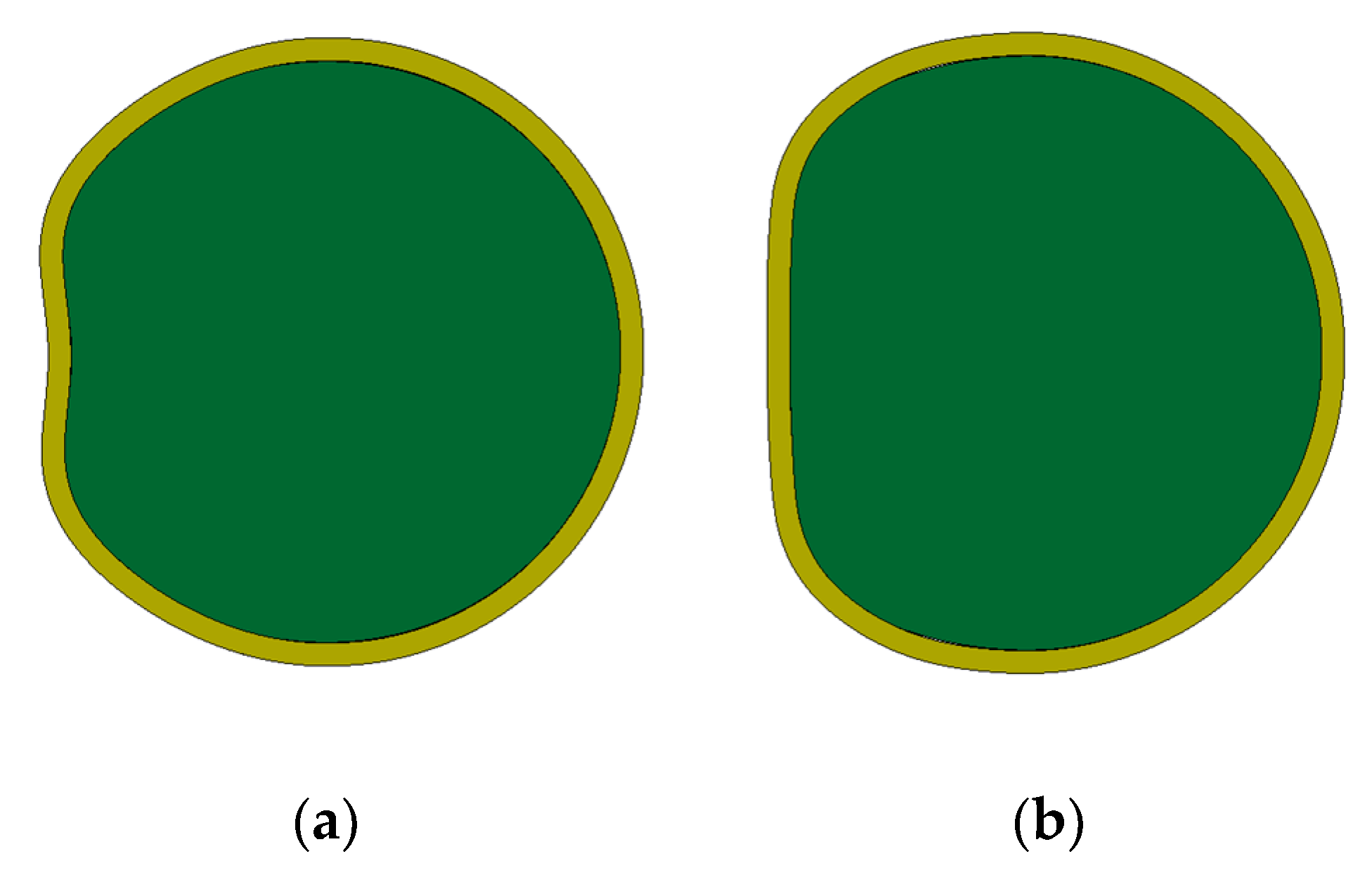
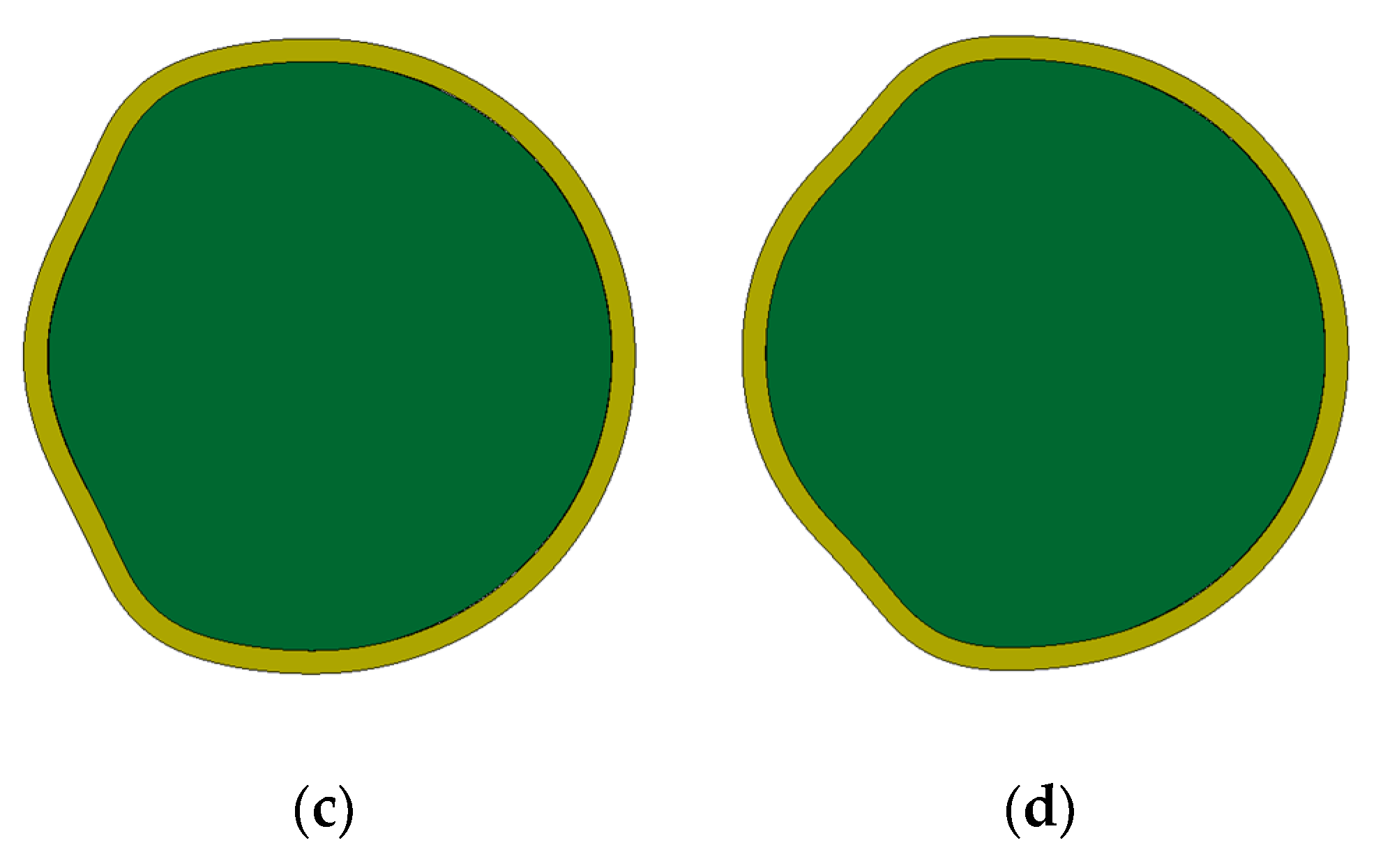
| D-Shaped | Radius of Initial Casing | Length of Straight Segment | Length of Arc Segment | Proportion of Straight Segment β |
|---|---|---|---|---|
| D-30° | 5.05 cm | 2.61 cm | 29.09 cm | 8.2% |
| D-60° | 5.05 cm | 5.05 cm | 26.44 cm | 16.1% |
| D-90° | 5.05 cm | 7.14 cm | 23.79 cm | 22.8% |
| D-120° | 5.05 cm | 8.75 cm | 21.15 cm | 29.2% |
| D-150° | 5.05 cm | 9.76 cm | 18.51 cm | 34.5% |
| Initial Radius of Casing | Width of Deforming Charge φ | |||||
|---|---|---|---|---|---|---|
| R0 (mm) | α = 20% | α = 22% | α = 24% | α = 26% | α = 28% | α = 30% |
| 30 | 46° | 53° | 60° | 69° | 77° | 85° |
| 40 | 46° | 53° | 60° | 69° | 77° | 85° |
| 50 | 46° | 53° | 60° | 69° | 77° | 85° |
| 60 | 46° | 53° | 60° | 69° | 77° | 85° |
| 70 | 46° | 53° | 60° | 69° | 77° | 85° |
| 80 | 46° | 53° | 60° | 69° | 77° | 85° |
| 90 | 46° | 53° | 60° | 69° | 77° | 85° |
| 100 | 46° | 53° | 60° | 69° | 77° | 85° |
| 110 | 46° | 53° | 60° | 69° | 77° | 85° |
| 120 | 46° | 53° | 60° | 69° | 77° | 85° |
| 130 | 46° | 53° | 60° | 69° | 77° | 85° |
| 140 | 46° | 53° | 60° | 69° | 77° | 85° |
| 150 | 46° | 53° | 60° | 69° | 77° | 85° |
| Width of Deforming Charge φ | α | |
|---|---|---|
| Simulation Result (LS-DYNA) | Calculation Result from Equation (19) | |
| 30° | 0.178 | 0.161 |
| 60° | 0.241 | 0.237 |
| 90° | 0.312 | 0.313 |
| 120° | 0.384 | 0.389 |
© 2018 by the authors. Licensee MDPI, Basel, Switzerland. This article is an open access article distributed under the terms and conditions of the Creative Commons Attribution (CC BY) license (http://creativecommons.org/licenses/by/4.0/).
Share and Cite
Ding, L.; Li, Z.; Lu, F.; Li, X. Rapid Evaluation and Analysis of the Deformation of Filled Cylindrical Casing with Deforming Charge Width Based on Self-Compiled MATLAB Program. Symmetry 2018, 10, 310. https://doi.org/10.3390/sym10080310
Ding L, Li Z, Lu F, Li X. Rapid Evaluation and Analysis of the Deformation of Filled Cylindrical Casing with Deforming Charge Width Based on Self-Compiled MATLAB Program. Symmetry. 2018; 10(8):310. https://doi.org/10.3390/sym10080310
Chicago/Turabian StyleDing, Liangliang, Zhenduo Li, Fangyun Lu, and Xiangyu Li. 2018. "Rapid Evaluation and Analysis of the Deformation of Filled Cylindrical Casing with Deforming Charge Width Based on Self-Compiled MATLAB Program" Symmetry 10, no. 8: 310. https://doi.org/10.3390/sym10080310





